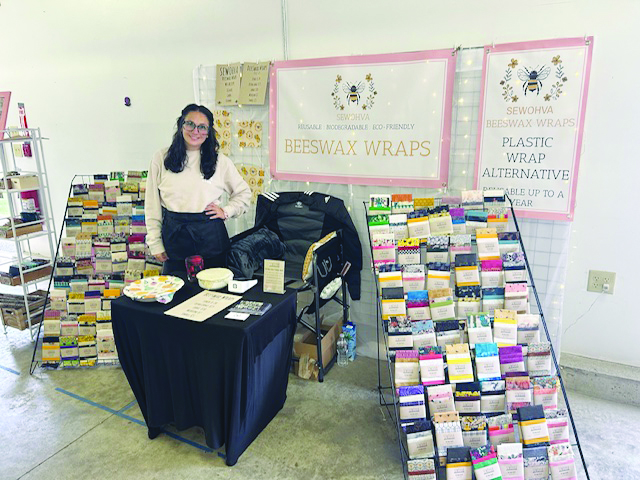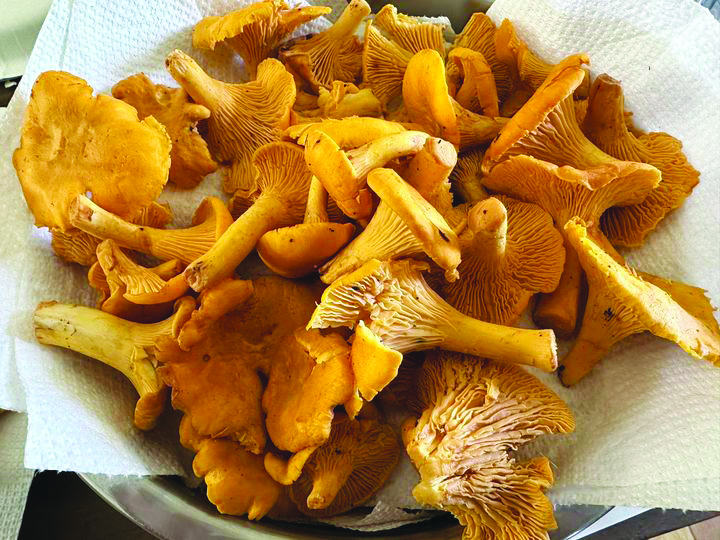Addie Leader-Zavos, Pastry Chef and co-owner of Eden’s Table Farm and Farm Store (240 Stark Highway North, Dunbarton, 774-1811, facebook.com/EdensTableFarm)
“I grew up in the middle of Washington, D.C. I loved to cook from a really young age. I got this book called Preserving the Seasons for my birthday when I was 9. It was fantastic, and the author was making things like apricots in lavender syrup, or brandied pears, and talking about walking out to the patio and picking fresh herbs. I was like, ‘That’s the life for me!’”
After exploring several different careers, Leader-Zavos went to culinary school at the Cordon Bleu in Boston and worked in fine dining restaurants that focused on seasonal menus. After being sidetracked by a back injury, she moved into pastry and opened a custom pastry and catering business specializing in dessert buffets and bespoke wedding cakes. After the Covid-19 lockdown, she and her husband, co-owner Michael Williams, bought Eden’s Table Farm in Dunbarton to focus on local and seasonal produce, locally produced farm products, and fresh baked goods.
What is your must-have kitchen item?
A digital scale. I love to bake, particularly now … there is no better way to ensure high-quality results than to be precise and consistent with measurements.
What would you have for your last meal?
Definitely my grandmother’s slow-cooked brisket with onions. My grandmother made brisket for every holiday and my mom makes it for holidays and every time she comes to visit. It’s just that instantly comforting meal that’s made even better by all the memories attached to it.
What is your favorite local eatery?
The Nepalese restaurant KS Kitchen in Manchester. The food is super-flavorful, well-crafted and perfectly seasoned, just absolutely delicious. Plus, I cannot turn down any form of dumpling and their momo is out of this world.
Name a celebrity you would like to see shopping at your farm store or eating something you’ve prepared.
Pastry chef and author Claudia Fleming. I really admire her style of baking and pastry-making; it’s very seasonal, uses lots of fresh local ingredients, and incorporates salty/savory notes.
What is your favorite thing you make or sell at the moment?
Our chocolate chunk cookie because it has such a great homey taste and texture, big chunks of dark chocolate and a nice kick of sea salt. We’re using regionally grown, freshly ground flours, chocolate from New Hampshire bean-to-bar chocolate maker Loon Chocolate, and an apple brandy from Flag Hill Distillery for top notes. It’s a classic that’s distinguished by the local ingredients we’re using and I hope we’ll be making it for years to come.
What is the biggest food trend you see in New Hampshire right now?
I’m really impressed with how New Hampshirites are coming together to improve opportunities for small farms and home-based food businesses right now. Last year HB 119 was passed, making it easier for small farms to have certain types of meat processed locally. Just a few days ago HB 1565 was passed, which makes it possible to sell pickles made in a home kitchen. Now the legislature is considering HB 1685, which would open up even more opportunities for small farms and food entrepreneurs. This trend of creating more opportunities for people who want to participate in the local food economy really benefits everyone who loves good food, so I hope we’ll see more of it.
What is your favorite thing to cook for yourself?
When I cook for the enjoyment of cooking, I take a dish and make it over and over again until I get it exactly the way I want it. But when I cook to feed myself I tend to keep it very simple — a fresh-picked cucumber sliced up and served with some homemade dip, a big bowl of roasted zucchini with a little soy sauce, or maybe a cheese omelet with fresh herbs and hot sauce. We have access to so many fresh, flavorful ingredients on the farm and through our farm store that I really don’t have to do much to create something very satisfying and enjoyable.
Featured Photo: Addie Leader-Zavos. Courtesy photo.






